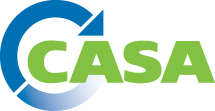One of the most frequent questions we have received in recent days is how the wastewater sector should continue to manage and protect its workforce on the ground in light of the COVID-19 pandemic. This is a separate consideration from conformance with new general workplace restrictions put in place by state and local orders, as collection and treatment facility workers often face a different set of challenges. CWEA has put together an informative webpage dedicated to this topic, with specific guidance and the latest news. The Water Environment Federation (WEF) has also put together a compendium of what water professionals need to know about COVID-19.
Of course, agencies must take actions that they feel are in the best interests of their workers and protection of public health, and circumstances may vary among individual agencies. However, CASA has independently consulted with expert microbiologists from across the nation on this issue, as well as our sister national Associations for the most up to date advice based on current science. The general consensus is that no additional precautions need to be taken by collection system workers or treatment facility workers at this time. For treatment facility workers, it is clear that the wastewater treatment process will inactivate COVID-19. We understand concern exists regarding workers who may come into contact with COVID-19 before the treatment process can inactivate it (i.e. in the collection system). According to the experts there has to be a significant outbreak of COVID-19 in a community before there would be a tangible risk to collection system workers. Even then, evidence to date does not indicate infectivity to be likely from raw wastewater. Thus, the expert recommendation is that normal personal protection equipment (PPE) should be utilized.
There has also been some question as to whether normal PPE included wearing N-95 masks. According to experts, N-95 masks are not typically part of PPE for wastewater workers and are difficult to use properly and effectively for a variety of reasons. If there is to be use of any mask at all, a surgical mask would likely be sufficient.
We will continue to monitor the situation, with a special eye on examples where a significant portion of the influent may be from infected persons (e.g. the military bases housing quarantined individuals) and will provide further information should the situation change. Special thanks are due to WEF and to the expert scientists who provided input on the guidance, including Chuck Gerba (U of AZ), Mark Sobsey (U of NC), Chuck Haas (Drexel) Kyle Bibby (Notre Dame), and Krista Wigginton (U of MI).
Procuring PPE
As facemasks and other essential PPE are in high demand as a result of this crisis, it may become more difficult for agencies to procure the necessary PPE to maintain operations and ensure worker safety. According to the California Special Districts Association (CSDA), special districts in need of PPE should contact their county office of emergency services or local Medical Health Operational Area Coordinator (MHOAC). The county by county contact list is available here. Currently medical services and skilled nursing facilities are getting priority for requests, though special districts may have their requests placed in a queue. CSDA is also tracking special districts’ PPE needs, so please contact Cole Karr at colek@csda.net if your agency is searching for equipment or if there is a lack of responsiveness on a critical need. Also, see the CASA COVID-19 “Agency Resources” page for more information about the California Water/Wastewater Agency Response Network (CalWARN) and the possibility of procuring additional PPE through that system.
UPDATE!
FEMA, US EPA, WARN & AWWA to Provide Cloth Face Masks to CA Water & Wastewater Utilities
California’s Recycled Water and Treated Wastewater is Safe from the COVID-19 Virus
Existing stringent state standards protect public from COVID-19. Fact Sheet
CDC
COVID-19 Informational Webpage
Water Research Australia
Fact Sheet



 @CASA_CleanWater
@CASA_CleanWater